Overview
This article shines a light on the nine symptoms of autistic burnout that parents should be mindful of, such as chronic fatigue and heightened sensory sensitivity. Understanding these symptoms is crucial, as they can significantly affect the emotional and physical well-being of individuals on the autism spectrum. By recognizing these signs, parents can provide the necessary support that their loved ones need. It’s important to foster awareness and adopt proactive management strategies to navigate these challenges effectively.
As a parent, you may notice changes in your child's behavior or energy levels. These symptoms can manifest in various ways, often leaving families feeling overwhelmed. Sharing experiences and insights can be invaluable, and we encourage you to reflect on your own journey. What signs have you noticed? How have you managed these challenges?
By staying informed and connected, we can create a supportive environment for those affected by autistic burnout. Let’s work together to raise awareness and develop strategies that promote well-being for individuals on the autism spectrum.
Introduction
In the intricate world of autism, the experience of autistic burnout stands out as a significant concern, deeply affecting individuals and their families. As awareness of this condition continues to expand, the need for resources and strategies to comprehend and manage burnout becomes increasingly essential. This article seeks to illuminate the definitions, symptoms, and causes of autistic burnout, while also offering practical recovery strategies and highlighting the vital role of community support. By exploring these elements, it aspires to empower caregivers and advocates with the knowledge needed to nurture resilience and well-being for those facing the challenges of autism.
Through a thorough examination of the emotional and physical repercussions of burnout, alongside its connection to migraines and long-term management strategies, this discussion underscores the importance of informed support systems in enhancing the quality of life for autistic individuals.
ASD Media: Essential Resources for Understanding Autistic Burnout
ASD Media offers a wide range of resources designed to inform parents and professionals about autism-related exhaustion. These resources include:
- Informative articles
- Engaging webinars
- Supportive community forums
These offerings explore the symptoms of autistic burnout, along with its causes and recovery strategies. By utilizing these offerings, families can cultivate a deeper understanding of their loved ones' experiences, empowering them to implement effective support strategies during challenging times.
Community involvement is crucial, as it fosters a sense of belonging and connection—principles emphasized in the motto from Anna Freud’s National Autism Trainer Programme. Recent studies highlight the significance of humor in connecting those with autism and their supporters, further enhancing the supportive atmosphere that ASD Media nurtures.
Moreover, case studies underscore the dangers of overloading children on the spectrum, stressing the necessity for caregivers to recognize their limits and allow time for recovery. As stated by Els for Autism, "The global mission of Els for Autism is to transform the lives of people with autism and those who care for them through lifetime services and collaborative partnerships." Through these resources, ASD Media not only provides families with knowledge but also fosters a collaborative community that supports the welfare of people with autism.
Definition of Autistic Burnout: What It Means
Autistic fatigue is a profound state of mental, physical, and emotional weariness that individuals on the autism spectrum may experience, particularly when navigating the challenges of a neurotypical environment. This condition often manifests as symptoms of autistic burnout, including:
- A significant decline in functioning
- Increased sensitivity to sensory inputs
- Difficulties in managing daily tasks
Research highlights the prevalence of autism-related fatigue, with studies underscoring its impact on overall well-being and quality of life. For example, McDonald's omega for Factor 7 (Social & Communication Impact) was found to be 0.856, illustrating a strong link between social and communication difficulties and the symptoms of autistic burnout experienced by individuals with autism. Understanding this phenomenon is crucial, as it sheds light on the unique stressors faced by those on the autism spectrum.
Protective factors, such as engaging in repetitive motor activities and pursuing special interests, can serve as rejuvenating practices. Additionally, self-awareness—characterized by improved interoception and reduced alexithymia—plays a vital role in managing fatigue.
Current research is also exploring the relationship between autism-related fatigue and the experiences of healthcare professionals, emphasizing the broader importance of understanding this condition. Ethical considerations in autism research further highlight the need for participant safety and the integrity of data collection, ensuring that the voices of those affected by autism-related fatigue are heard and valued.
We invite you to consider these insights and share your experiences, as together we can foster a deeper understanding and support for individuals navigating these challenges.
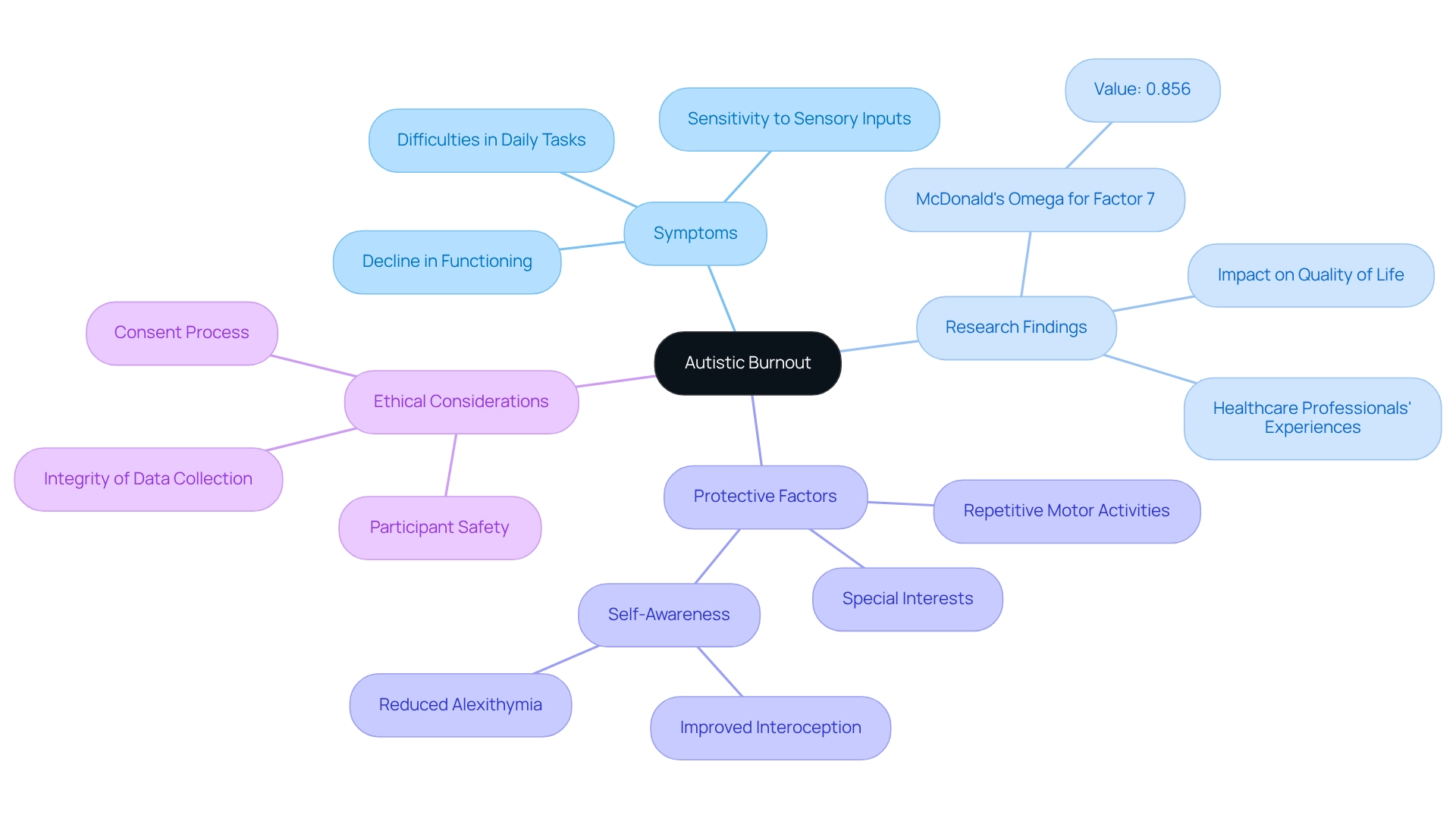
Common Symptoms of Autistic Burnout: Key Indicators
Recognizing the symptoms of autistic burnout is vital for providing the right support, especially considering the 955 Twitter posts and 172 Wrong Planet posts that highlight this important issue. Common indicators include:
- Chronic Fatigue: A persistent sense of exhaustion that lingers even after sufficient rest.
- Increased Sensory Sensitivity: Heightened sensitivity to sensory inputs, like sounds or lights, which can lead to discomfort.
- Emotional Volatility: Mood swings, including increased irritability, anxiety, or feelings of sadness.
- Withdrawal: A noticeable tendency to pull back from social interactions and activities.
- Difficulty with Executive Functioning: Challenges in planning, organizing, and completing tasks effectively.
- Physical Symptoms: Issues such as headaches, muscle tension, and gastrointestinal problems may also arise.
Understanding the symptoms of autistic burnout is crucial, as research indicates that many individuals with autism experience ongoing fatigue and sensory sensitivity, which can amplify feelings of exhaustion. The importance of enhanced communication within the neurodiverse community is underscored in the case study 'Ask the Experts,' emphasizing the need for greater awareness and proactive management strategies. As noted by Els for Autism, 'The global mission of Els for Autism is to transform the lives of people with autism and those who care for them through lifetime services and collaborative partnerships.' This statement underscores the significance of support and collaboration in recognizing and addressing the symptoms of autistic burnout.
We encourage you to share your experiences and insights in the comments or through our newsletters, fostering a community of understanding and support.
Impact of Autistic Burnout: Emotional and Physical Consequences
The symptoms of autistic burnout can deeply affect both emotional and physical well-being. Emotionally, individuals may struggle with feelings of hopelessness, anxiety, and isolation, which can intensify the symptoms of autistic burnout and contribute to their overall distress. Recent studies highlight the importance of heightened awareness and acceptance of autism in preventing and recovering from exhaustion, underscoring the need for supportive environments. Fostering such awareness can significantly alleviate the emotional burden of exhaustion.
Physically, exhaustion can manifest as chronic pain, fatigue, and a decline in overall health, which can greatly hinder daily functioning and quality of life. Case studies show that participants who used strategies like rest and sensory avoidance reported improvements in managing their energy levels. These strategies align with findings from the case study titled 'Strategies for Managing Demands and Energy,' emphasizing the importance of managing demands to prevent exhaustion.
Identifying these indicators early is vital for caregivers. Addressing fatigue promptly can lead to better outcomes and enhance the overall well-being of those affected by the symptoms of autistic burnout. As User T98 poignantly shared, "I was told for years that avoiding things will only make everything worse... Exposure there makes it WORSE because it causes overload, then exhaustion. Avoidance HELPS this." This perspective highlights the need for tailored approaches to recovery, reminding us that understanding and compassion are key in this journey.
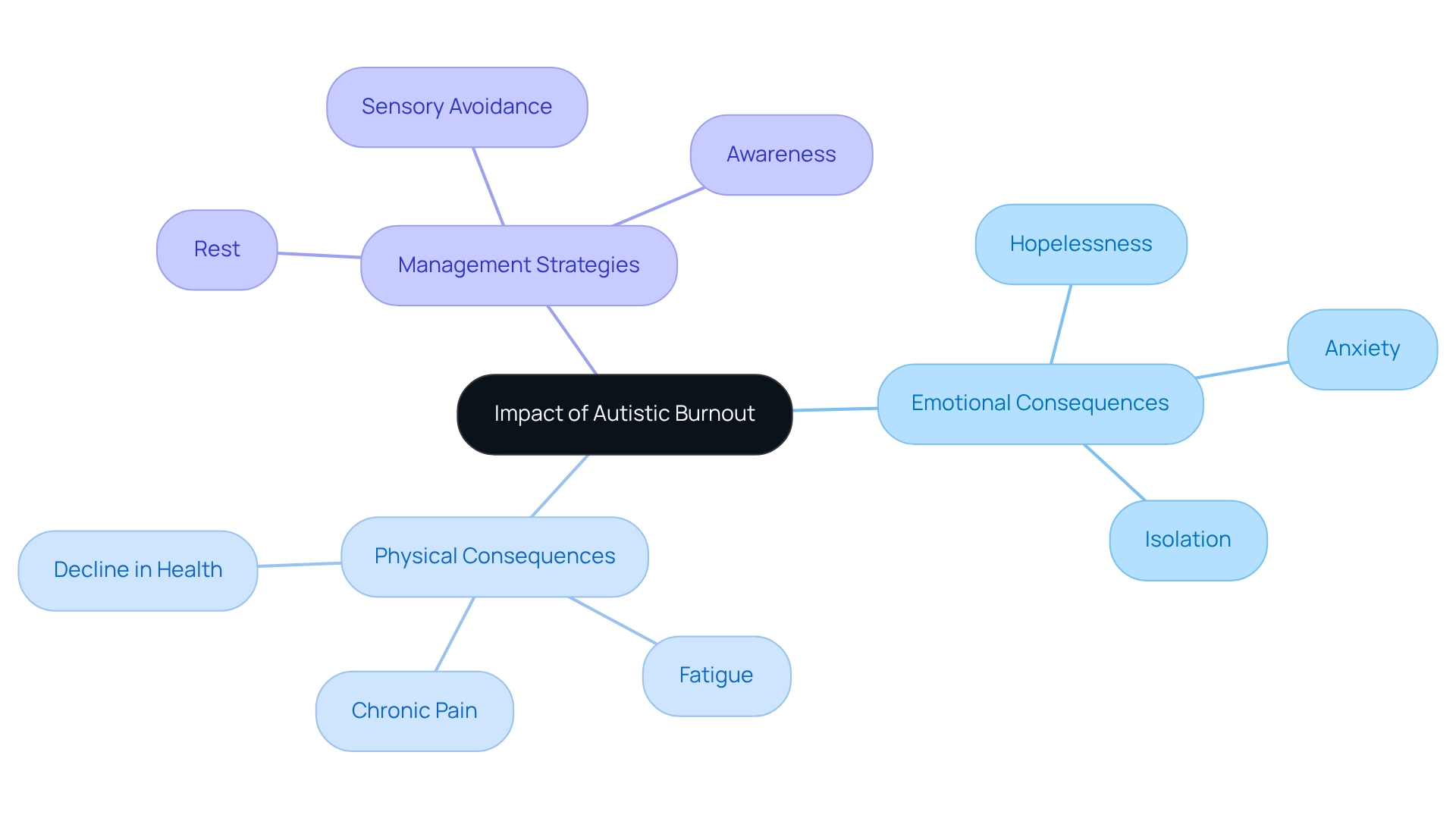
Causes of Autistic Burnout: Understanding the Triggers
Various factors can trigger symptoms of autistic burnout, each contributing to the overall stress experienced by individuals on the spectrum. Understanding these triggers is crucial for parents and advocates, as it empowers them to support their loved ones effectively. Here are some key triggers to consider:
- Sensory Overload: Exposure to overwhelming sensory stimuli, such as loud noises or bright lights, can lead to significant exhaustion. Effective management strategies, like stimming and deep pressure techniques, can help reduce these effects, enabling individuals to maintain sensory balance and relieve stress. A case study titled "Coping Strategies for Managing Sensory Overload" discusses various coping methods that have proven effective in assisting those on the spectrum.
- Social Demands: The pressure to conform to social norms often creates an additional burden for individuals with autism, making social interactions especially exhausting and resulting in heightened fatigue. Expert Joseph Barimo emphasizes that understanding these social demands is essential, as they greatly influence the emotional well-being of individuals on the spectrum.
- Masking: The effort to conceal neurodivergent traits to fit in can drain emotional resources, leading to increased stress and eventual exhaustion.
- Life Changes: Transitions, like starting school or a new job, can exacerbate stress levels, as these changes often require adjustments that may feel overwhelming.
- Lack of Support: Insufficient understanding and accommodations from family, schools, and workplaces can significantly contribute to feelings of isolation and exhaustion. Expert opinions highlight the importance of supportive environments to help mitigate these challenges.
Recognizing these triggers allows parents and advocates to implement proactive strategies that assist individuals on the spectrum in managing daily life and reducing the symptoms of autistic burnout. For instance, creating a sensory-friendly atmosphere at home and encouraging open dialogue about social expectations can alleviate some pressures faced by those on the autism spectrum. Furthermore, recent statistics indicate that a significant proportion of individuals report experiencing exhaustion due to these triggers, underscoring the need for awareness and intervention. By fostering understanding and support, we can help create a more nurturing environment for everyone.

Recovery Strategies for Autistic Burnout: Practical Approaches
Recovery from autistic burnout requires a compassionate and multifaceted approach, incorporating several effective strategies to support healing:
- Rest and Recharge: Prioritize downtime to facilitate recovery, allowing individuals to regain energy and mental clarity.
- Reduce Sensory Input: Create a calming environment that minimizes sensory overload, significantly alleviating stress and anxiety.
- Establish Routines: Consistent daily routines provide a sense of stability and predictability, essential for emotional well-being.
- Seek Professional Help: Engaging with therapists or counselors offers valuable assistance and customized coping strategies, enhancing recovery outcomes.
- Engage in Self-Care: Incorporate activities that promote relaxation and well-being, such as mindfulness practices or gentle exercise, crucial for emotional and physical health.
As the saying goes, "Even on your toughest days, remember that you are loved, you are enough, and you are making a difference." This powerful sentiment underscores the importance of self-empowerment during recovery. Research indicates that self-care is vital in recovering from sensory exhaustion, with effective strategies leading to enhanced emotional resilience. Moreover, professional guidance has been shown to significantly improve recovery rates, highlighting the importance of seeking support when needed. By implementing these strategies, individuals can navigate the challenges of autistic burnout symptoms more effectively, fostering a path toward renewal and hope.
Remember, "The sun always rises after the darkest night," symbolizing the positive outcomes that can emerge from these recovery efforts. Insights from the case study titled 'Meaning-Making in Therapy' further emphasize that individuals can actively shape their recovery experiences, reinforcing the theme of empowerment. The Positive Psychology Toolkit©, updated monthly and grounded in science, supports the effectiveness of these self-care practices. By integrating these strategies, individuals can embark on a journey toward healing and resilience, nurturing their well-being every step of the way.

Connection Between Autistic Burnout and Migraines: What to Know
Studies emphasize a significant connection between autistic fatigue and migraines, highlighting that many individuals on the autism spectrum experience heightened sensory sensitivities, which can trigger migraines during episodes of fatigue. The stress and exhaustion associated with these challenges not only amplify migraine symptoms but also create a difficult cycle of discomfort. For example, research indicates that sensory sensitivities can lead to an increase in migraine frequency, underscoring the importance of effective management strategies. Understanding this connection is crucial for parents and caregivers, as it enables them to provide better support and treatment options tailored to the unique experiences of those with autism.
Recent findings suggest that teaching self-care techniques can empower individuals to proactively manage their migraines, further illustrating the importance of addressing both sensory sensitivities and fatigue in treatment plans. Additionally, preparing children for their experiences in ABA therapy can aid in managing sensory sensitivities during burnout, as noted in the case study "Empowering Your Child for a Successful Start in ABA Therapy." Incorporating non-medical approaches can also enhance overall well-being for individuals with autism.
As Anderson, J. L. observed, navigating the complexities of managing both autism and migraines can be overwhelming for families, highlighting the necessity for comprehensive strategies. Statistics reveal that migraine prevalence is significantly higher in individuals with autism, reinforcing the urgency of addressing these issues. By focusing on self-care techniques and thoughtful planning, parents can more effectively support their children in coping with the challenges of sensory overload and migraines.
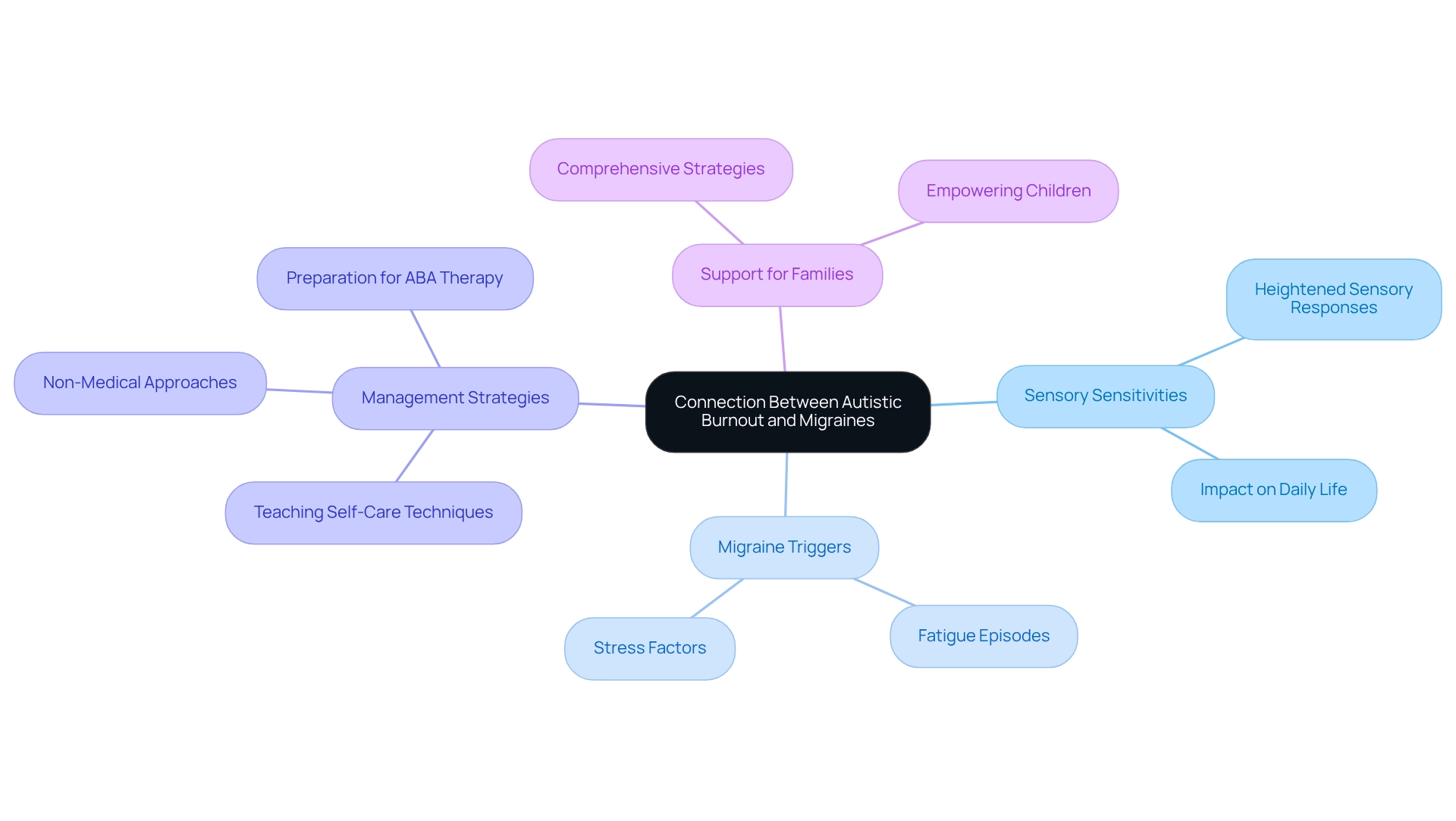
Long-Term Management Strategies for Autistic Burnout
Effectively managing the symptoms of autistic burnout over the long term requires a multifaceted approach that nurtures both mind and spirit.
- Ongoing Self-Care: It’s vital to prioritize regular activities that enhance your mental and physical well-being. Consider incorporating mindfulness practices, engaging in exercise, or pursuing hobbies that bring you joy and relaxation.
- Community Assistance: Engaging with support groups or networks can foster a sense of belonging. These connections not only provide opportunities for shared experiences but also offer encouragement. Research shows that community support significantly enhances emotional resilience among autistic individuals, making these relationships essential for recovery.
- Education: Staying informed about autism and the nuances of burnout is crucial. Understanding personal triggers and developing coping mechanisms can empower you to navigate challenges more effectively. For instance, the case study titled "Importance of Customized Educational Plans" highlights that many students with autism benefit from Individualized Education Programs (IEPs) to address social and communication difficulties in academic settings.
- Advocacy: Taking an active role in advocating for necessary accommodations in educational and workplace environments can significantly alleviate stress. This includes pushing for IEPs tailored to the unique needs of students on the autism spectrum, which have been shown to improve both academic success and social integration. As Kyle Coddington, CEO of Prospera Healthcare, states, "Offering customized, in-home ABA therapy to assist children with autism throughout Texas develop lasting skills and flourish" underscores the importance of personalized support in overcoming challenges faced by individuals with autism. Notably, studies indicate that 73.6% of students with autism obtain a high school diploma, emphasizing the critical role of tailored assistance in achieving educational milestones. Additionally, mental health experts stress the essential role of self-care and community support in recovering from the symptoms of autistic burnout, reinforcing the need for a nurturing network. By embracing these approaches, you can more effectively manage sensory overwhelm and enhance your overall quality of life.
Community Support: A Vital Component in Recovering from Autistic Burnout
Community support plays a pivotal role in the recovery from symptoms of autistic burnout by offering both emotional relief and practical guidance. Engaging with others who share similar experiences fosters a sense of belonging and understanding, which is crucial for navigating the complexities of autism. Support groups, whether online or in-person, create a safe environment for individuals to share their challenges and strategies for coping with the symptoms of autistic burnout, significantly aiding in the recovery process. Research shows that involvement in these groups can lead to enhanced mental health outcomes, as people feel less isolated and more empowered.
Paula Holmes, a licensed clinical social worker, emphasizes, "Network systems are crucial for persons confronting the challenges of autism, as they offer not only emotional assistance but also practical strategies for managing daily life." Furthermore, connecting with experts who specialize in autism provides tailored resources and support, improving the recovery journey. A case study titled "Providing Resources and Information" highlights how access to community resources empowers families to make informed decisions, ultimately supporting individuals with autism in their development.
As we move through 2025, the significance of these support networks continues to grow, with effective groups emerging that specifically cater to the needs of parents of children with autism. Statistics reveal that 32.8% of children aged 12-17 received only medication treatment, emphasizing the necessity for comprehensive support to address the symptoms of autistic burnout beyond medication. Expert opinions suggest that these assistance systems are not merely beneficial but essential for effectively managing neurodivergent fatigue.
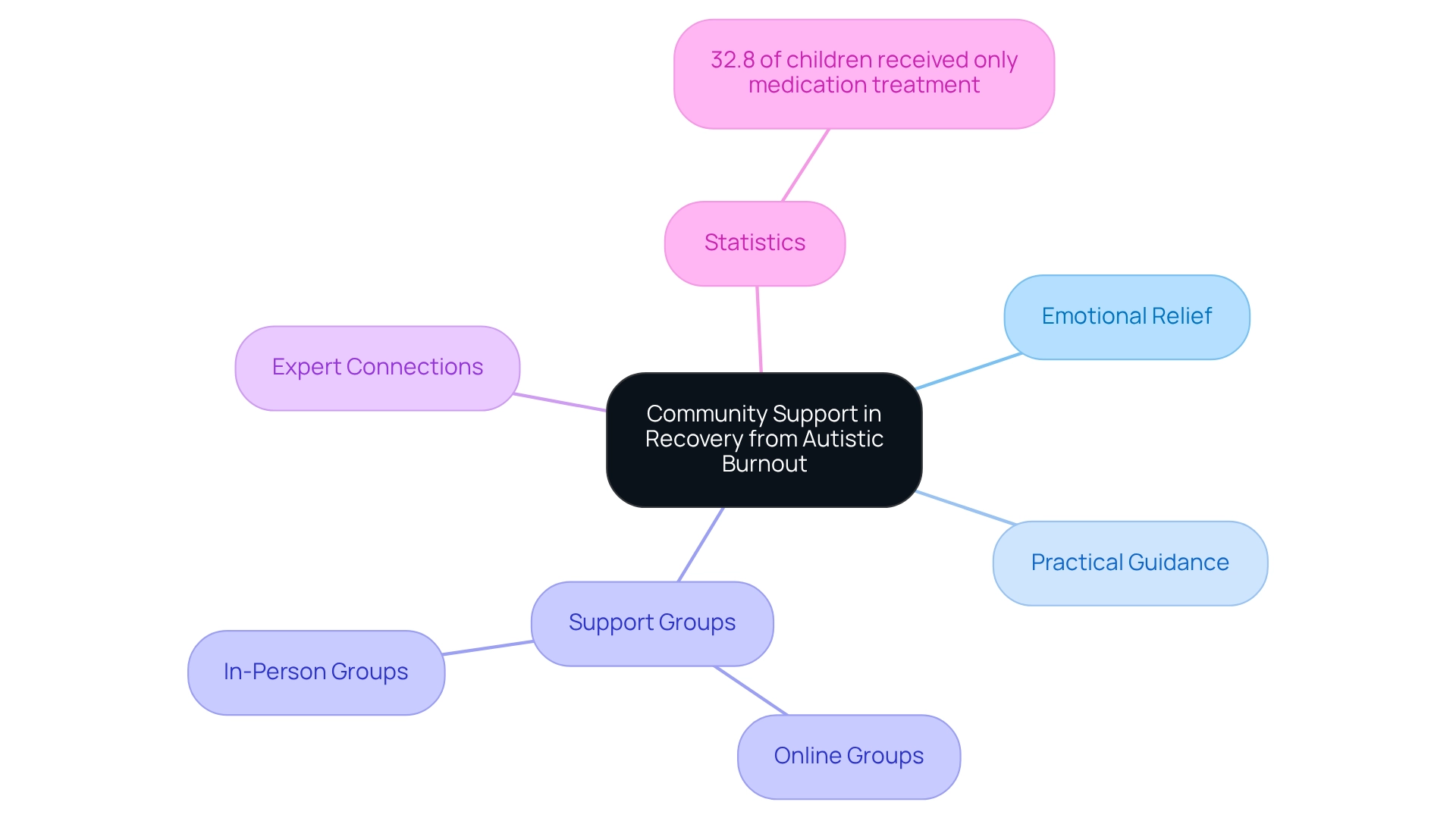
Helpful Resources and Links for Understanding Autistic Burnout
To truly understand and manage sensory exhaustion, it's essential to explore valuable resources that can provide support:
- Autism Speaks - This organization offers a wealth of resources tailored for families navigating autism, ensuring you’re not alone in this journey.
- Neurodivergent Insights - Their comprehensive guide on recognizing and addressing sensory exhaustion includes practical worksheets and techniques that can make a difference.
- Reframing Autism - This platform shares self-care strategies and insights directly from neurodivergent individuals, helping families tackle the challenges of exhaustion with compassion and understanding.
Research shows that early diagnosis and intervention can significantly enhance outcomes. Children diagnosed by age three are more likely to achieve independence as adults (source: CDC). Moreover, with autism diagnoses now at 1 in 36 children nationwide, there is a pressing need for accessible support resources. Parents are increasingly turning to online tools, and studies indicate that these resources can effectively aid in understanding and managing the symptoms of autistic burnout. As the autism community continues to expand, the importance of equitable access to information and support is more crucial than ever. We encourage you to seek these resources and share your experiences, fostering a community of understanding and support.
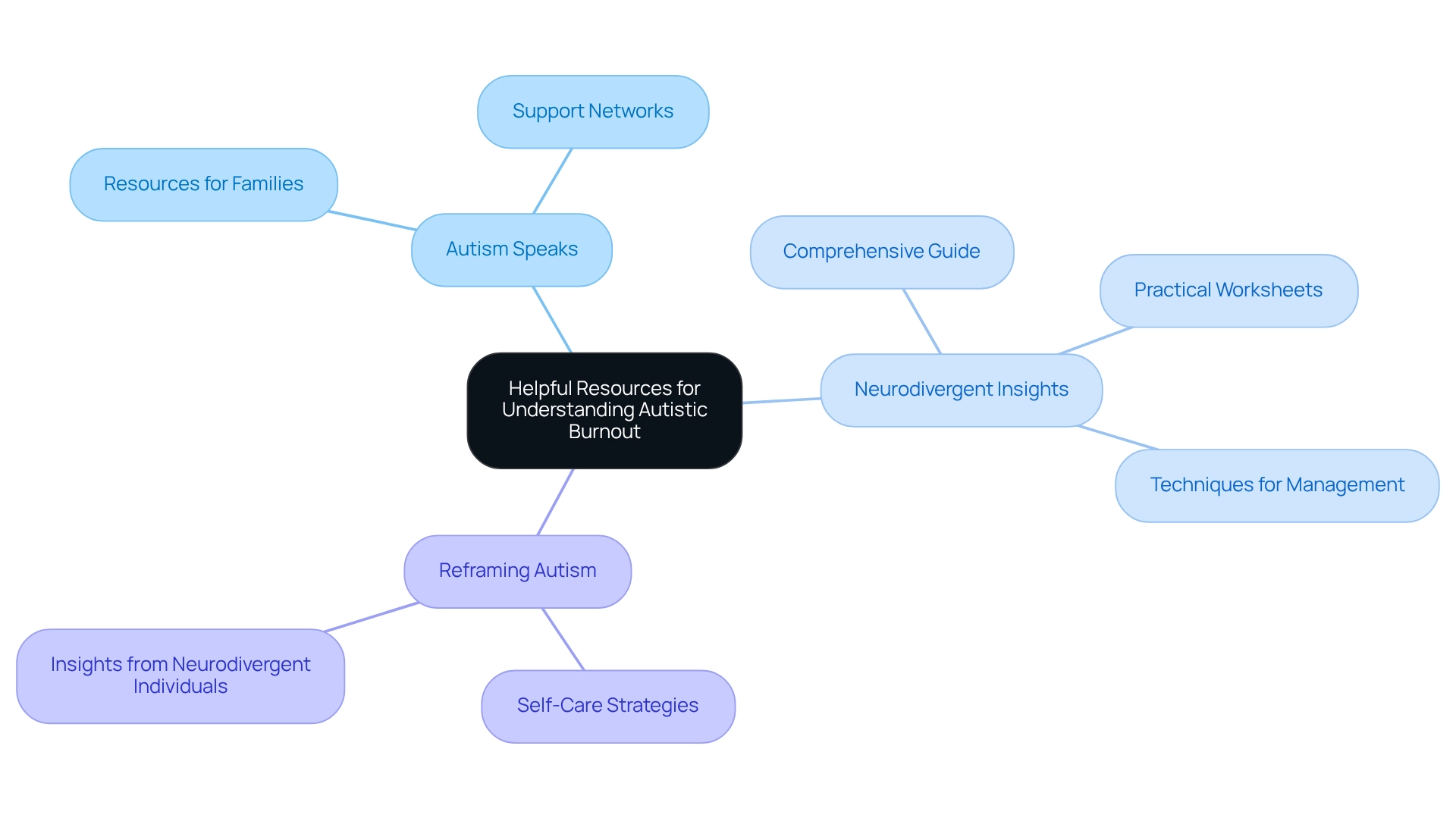
Conclusion
Understanding autistic burnout is crucial in supporting individuals on the autism spectrum and their families. This article has explored the definition of autistic burnout, its common symptoms, and the emotional and physical impacts it can have on daily life. Recognizing triggers such as sensory overload, social demands, and the pressure to mask empowers caregivers to create supportive environments that mitigate these challenges.
Recovery strategies play a vital role in managing burnout. Emphasizing the importance of rest, reducing sensory input, and establishing routines can significantly enhance recovery outcomes. Additionally, seeking professional help and engaging in self-care activities are essential steps toward regaining emotional and physical well-being. The connection between autistic burnout and migraines further underscores the need for comprehensive support and effective management strategies.
Community support emerges as a fundamental component in the recovery process. By fostering connections with others who share similar experiences, individuals can find solace and practical guidance. Support groups, resources, and advocacy efforts can significantly improve the quality of life for those affected by autism. As awareness of autistic burnout continues to grow, it is imperative to prioritize informed support systems that nurture resilience and well-being. Together, we can ensure that individuals with autism thrive in their daily lives.
Frequently Asked Questions
What resources does ASD Media offer to support understanding of autism-related exhaustion?
ASD Media offers a variety of resources including informative articles, engaging webinars, and supportive community forums that explore symptoms of autistic burnout, its causes, and recovery strategies.
How can families benefit from the resources provided by ASD Media?
Families can gain a deeper understanding of their loved ones' experiences with autism, empowering them to implement effective support strategies during challenging times.
Why is community involvement emphasized by ASD Media?
Community involvement fosters a sense of belonging and connection, which is crucial for supporting individuals with autism and their caregivers.
What role does humor play in the support of individuals with autism?
Recent studies highlight that humor can enhance connections between those with autism and their supporters, contributing to a more supportive atmosphere.
What are the symptoms of autistic burnout?
Symptoms of autistic burnout include a significant decline in functioning, increased sensitivity to sensory inputs, and difficulties in managing daily tasks.
What protective factors can help manage autism-related fatigue?
Engaging in repetitive motor activities, pursuing special interests, and improving self-awareness can serve as rejuvenating practices for individuals experiencing autism-related fatigue.
How does ASD Media address the dangers of overloading children on the autism spectrum?
Case studies emphasize the importance of caregivers recognizing their limits and allowing time for recovery to prevent overload in children on the spectrum.
What is the global mission of Els for Autism?
The mission of Els for Autism is to transform the lives of people with autism and those who care for them through lifetime services and collaborative partnerships.
Why is it important to recognize the symptoms of autistic burnout?
Recognizing these symptoms is vital for providing appropriate support, as many individuals with autism experience ongoing fatigue and sensory sensitivity that can exacerbate feelings of exhaustion.
What common indicators signal autistic burnout?
Common indicators include chronic fatigue, increased sensory sensitivity, emotional volatility, withdrawal from social interactions, difficulty with executive functioning, and physical symptoms like headaches and muscle tension.




